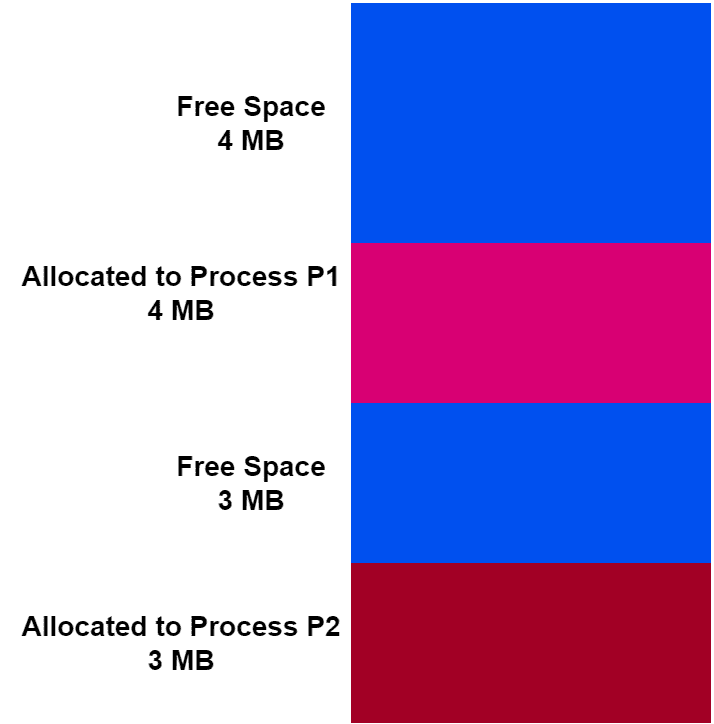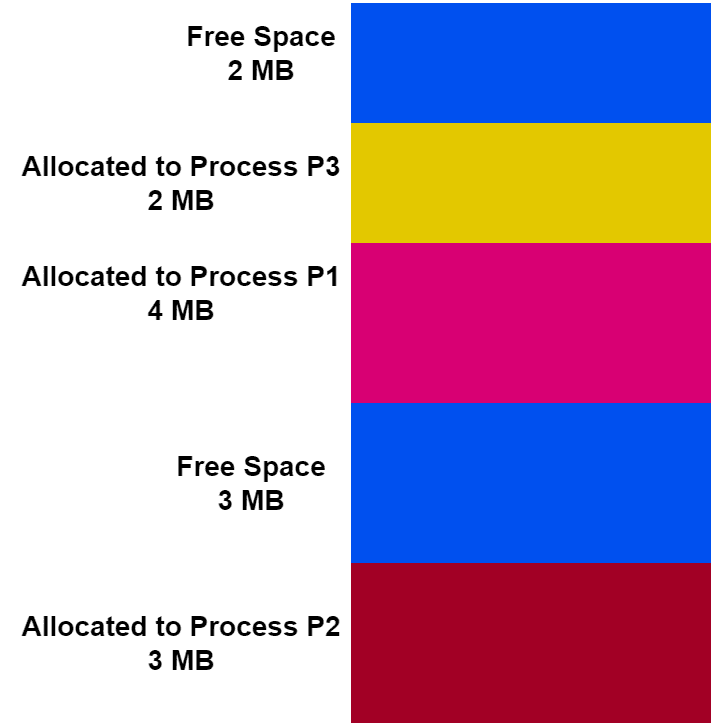1. 概述
在本教程中,我们将通过一个实际案例,探讨操作系统中的外部碎片化(External Fragmentation)问题。此外,我们还将分析导致外部碎片化的主要原因,并讨论其对系统性能和内存管理的影响。
2. 什么是外部碎片化?
外部碎片化是操作系统内存管理中常见的问题,表现为内存中存在大量空闲空间,但由于这些空间不连续,无法被有效利用。
也就是说,虽然总的可用内存足够,但由于这些内存被分割成多个小块,导致无法为需要较大连续内存的进程分配空间。
✅ 举个例子来说明:
假设系统总共有14MB内存,初始状态下,两个进程 P1 和 P2 分别占用了7MB内存:

此时,系统还剩下7MB空闲内存。接下来,启动一个新的进程 P3,它需要2MB内存:

现在系统还剩下5MB空闲内存,但它们被分散在两个不连续的区域中。接着,系统尝试启动另一个进程 P4,它需要4MB内存:
虽然系统总共有5MB可用内存,但由于内存不连续,无法为 P4 分配足够的连续空间。
❌ 问题来了:
即使总的可用内存大于进程需求,也无法利用这些空间。
✅ 解决方法之一:
合并空闲内存块,形成一个连续的大块内存:

3. 外部碎片化产生原因与解决策略
3.1 产生原因
外部碎片化通常发生在以下场景中:
- 内存分配和释放不规则,导致空闲内存块大小不一
- 内存管理器在分配内存时没有合理规划,留下大量无法使用的“缝隙”
- 系统频繁分配和释放不同大小的内存块
这些小块空闲内存累积起来,虽然总量足够,但因为不连续,无法满足新进程的分配需求。
3.2 常见解决策略
以下是几种常见的减少外部碎片化的技术:
| 方法 | 说明 |
|---|---|
| Buddy 算法(Buddy Memory Allocation) | 将内存划分为大小为2的幂次方的块,分配时尽量匹配合适的块大小,减少碎片 |
| 内存压缩(Compaction) | 将内存中的进程移动,使空闲块合并成连续区域 |
| 虚拟内存(Virtual Memory) | 将不常用的数据交换到磁盘,缓解物理内存碎片问题 |
| 垃圾回收(Garbage Collection) | 自动回收不再使用的内存,减少碎片产生 |
⚠️ 注意:
这些方法各有优劣,实际操作系统中往往结合使用,以达到最佳效果。
4. 外部碎片化的影响
外部碎片化会给系统带来以下几个主要问题:
| 影响 | 说明 |
|---|---|
| ✅ 内存利用率下降 | 空闲内存被分散,无法被有效利用 |
| ❌ 性能下降 | 内存分配时需额外查找合适的连续块,增加开销 |
| ⚠️ 大内存块分配失败 | 即使总内存足够,也无法分配连续的大块内存 |
| ⚠️ 碎片随时间增长 | 频繁分配/释放导致碎片越来越多 |
| ❌ 内存管理复杂度上升 | 系统需维护更多内存块信息,管理效率下降 |
这些影响会随着时间推移而加剧,尤其在长期运行的系统中更为明显。
5. 总结
本文通过一个实际内存分配案例,详细解释了外部碎片化的形成过程,分析了其产生的原因,并介绍了常见的应对策略。外部碎片化虽不可避免,但通过合理的内存管理算法和系统设计,可以有效缓解其影响。
作为开发者或系统工程师,理解外部碎片化有助于我们在内存密集型应用中做出更优的设计决策,避免踩坑。